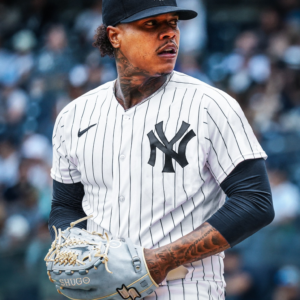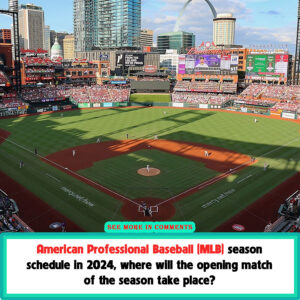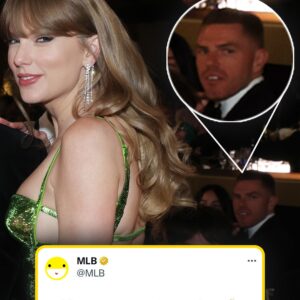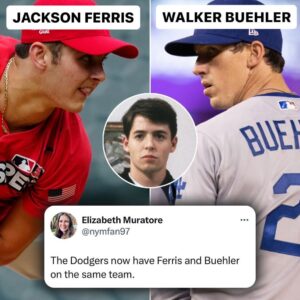Ohtani, Betts, Freeman: Best MLB batting trio of all time?
Photo by Brian Rothmuller/Icon Sportswire
One of the highlights of the 2024 MLB season will take place in the early morning hours of March 21 when the Los Angeles Dodgers and San Diego Padres open the regular season with a game in Seoul, South Korea.
Yoshinobu Yamamoto will be the likely starter for the Dodgers, and that will certainly engage our curiosity, but I’m looking forward to seeing how Dave Roberts lines up his magnificent trio of hitters: Mookie Betts, Freddie Freeman and Shohei Ohtani (probably in that order, putting his best slugger behind the other two).
Is there a nickname yet for these guys? I’m sure Dodgers fans will come up with one soon enough. Among those unavailable, due to copyright infringement of previously adopted monikers: Murderers’ Row, The Bombers, The Lumber Company, The Big Red Machine (wrong team color anyway), Harvey’s Wallbangers, The Blake Street Bombers, The Killer B’s, Crush City, the Bomba Squad and Slam Diego.
Ohtani, Betts and Freeman were all among baseball’s best hitters in 2023, ranking, respectively, first, fifth and seventh in both OPS and slugging percentage; third, seventh and ninth in batting average; and third, fifth and six in total bases. If all three repeat those performances, they have a chance to become one of the greatest trios of offensive teammates of all time.
With the offseason crawling along, let’s dig into some of the numbers at Baseball-Reference.com to see how the Dodgers’ three might compare to some of the other all-time trios.
Where to start? We could just look at home runs:
1. 1961 Yankees, 143: Roger Maris (61), Mickey Mantle (54), Bill Skowron (28)
2. 2023 Braves, 135: Matt Olson (54), Ronald Acuna Jr. (41), Marcell Ozuna (40)
3. 2001 Giants, 132: Barry Bonds (73), Rich Aurilia (37), Jeff Kent (22)
4. 1997 Rockies, 130: Larry Walker (49), Andres Galarraga (41), Vinny Castilla (40)
5. 1996 Mariners, 129: Ken Griffey Jr. (49), Jay Buhner (44), Alex Rodriguez (36)
That’s a fun list — and note the presence of the 2023 Braves. Ohtani (44), Betts (39) and Freeman (29) combined for 112 home runs, an impressive total, but hardly a historic number. Of course, we know there is more to offense than just home runs. Consider the top team on the list: Maris set the single-season home run record that stood until Mark McGwire broke it in 1998, and Mantle was right with him all season until tailing off in September. That was an expansion year in the American League, and there were monster offensive seasons all over the place. Check out the OPS leaders:
Norm Cash, Tigers: .361/.487/.662, 41 HR, 1.148
Mantle, Yankees: .317/.448/.687, 54 HR, 1.135
Jim Gentile, Orioles: .302/.423/.646, 46 HR, 1.069
Harmon Killebrew, Twins: .288/.405/.606, 46 HR, 1.012
Maris, Yankees: .269/.372/.620, 61 HR, .993
OPS is a better barometer for offensive performance than just home runs, and in the context of the 1961 season, Maris was arguably only the fifth- or sixth-best hitter in the AL. And the National League had Frank Robinson, Willie Mays, Henry Aaron and Orlando Cepeda all putting up monster numbers as well.
Ohtani Joins Dodgers For $700 Million
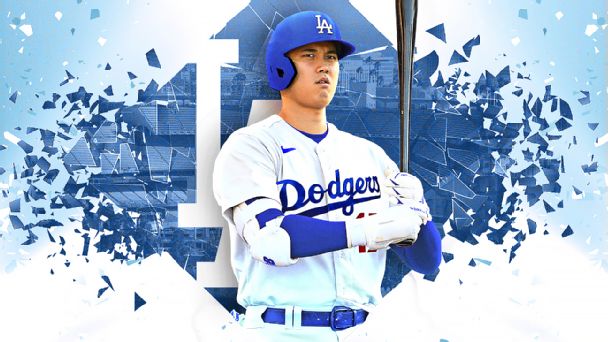
Baseball’s marvel is headed to the other side of L.A. on a contract that blows away any in the history of the sport. Here’s what to make of the 10-year deal.
If we turn to OPS, we see that Ohtani (1.066), Betts (.987) and Freeman (.976) each had an OPS over .975. Only 11 teams since 1900 have had three qualified hitters with an OPS that high (not including the 2020 Braves, but we’re ignoring any shortened seasons here). Not surprisingly, all 11 of those occurrences came during the two highest-scoring eras in major league history, between 1925 and 1937 and between 1996 and 2004.
There have been four teams with three players with a 1.000 or greater OPS:
1. 1929 Cubs: Rogers Hornsby (1.139), Hack Wilson (1.044), Riggs Stephenson (1.006)
2. 1996 Mariners: Edgar Martinez (1.059), Alex Rodriguez (1.045), Ken Griffey Jr. (1.020)
3. 2000 Astros: Jeff Bagwell (1.039), Moises Alou (1.039), Richard Hidalgo (1.028)
4. 2004 Cardinals: Albert Pujols (1.072), Jim Edmonds (1.061), Scott Rolen (1.007)
Three of those teams feature multiple Hall of Famers — Hornsby and Wilson; Martinez and Griffey; Pujols and Rolen. (The Astros did have a second Hall of Famer in Craig Biggio, although he had mere .780 OPS that season.) Keep these teams in mind; they could pop up again when we get to our final list.
I mentioned that Ohtani, Betts and Freeman ranked first, fifth and seventh in the majors in OPS. Here’s another way to look at this: How often does one team place three of its hitters in the top 10 in the majors in OPS? While rare, it’s hardly unprecedented: It’s happened 19 times since the start of the live-ball era in 1920, including the 2023 Braves with Acuna (third), Olson (fourth) and Ozuna (ninth).
Three teams had four players in the top 10:
— 1976 Reds: Joe Morgan (first), George Foster (fourth), Pete Rose (seventh) and Ken Griffey Sr. (10th). That doesn’t even include Johnny Bench, who had a poor season in 1976, or Hall of Famer Tony Perez. Will any of the Big Red Machine trios make our top 10? (Not to spoil anything, but … no.)
— 1933 Yankees: Lou Gehrig (second), Babe Ruth (fourth), Bill Dickey (eighth), Tony Lazzeri (ninth). That’s four Hall of Famers.
— 1933 A’s: Jimmie Foxx (first), Mickey Cochrane (fifth), Bob Johnson (seventh), Pinky Higgins (10th). Yes, that’s two teams with eight of the top 10. Here’s what’s amazing though: The Washington Senators, and not the Yankees or A’s, won the AL pennant.
Oh, and how about this: The 1953 Brooklyn Dodgers had five players in the top 10: Duke Snider (second), Roy Campanella (fifth), Carl Furillo (sixth), Gil Hodges (ninth), Jackie Robinson (10th). They were certainly one of the greatest offenses of all time, scoring 955 runs — 187 runs more than any other NL team — but they won’t make the top 10 trios either.
Another team to note here: the 1963 Giants, as Willie Mays, Orlando Cepeda and Willie McCovey ranked second, third and fourth in OPS behind only Henry Aaron. The Giants, however, not only finished just third in the NL but somehow didn’t even lead the league in runs scored.
Of course, raw OPS is hardly a perfect stat either since it isn’t park- or era-adjusted. Those 2000 Astros had Bagwell, Alou and Hidalgo with a 1.000 OPS — but there were a ridiculous 19 hitters in the majors that season with a 1.000 OPS (as opposed to just three in 2023). OPS+ makes those park and era adjustments. Weight runs created (wRC+) is even better, since OPS slightly over values slugging and undervalues on-base percentage.
Both OPS+ and wRC+ are rate stats, however, not accounting for playing time. A 150 OPS+ or 150 wRC+ over 650 plate appearances compared to 550 are not of equal value. So, to compile my ultimate list of best trios, let’s use Baseball-Reference’s batting runs metric, which tells us how many estimated runs a hitter created compared to an average hitter from that season, with the appropriate park adjustments.
Rating the offseason’s marquee moves
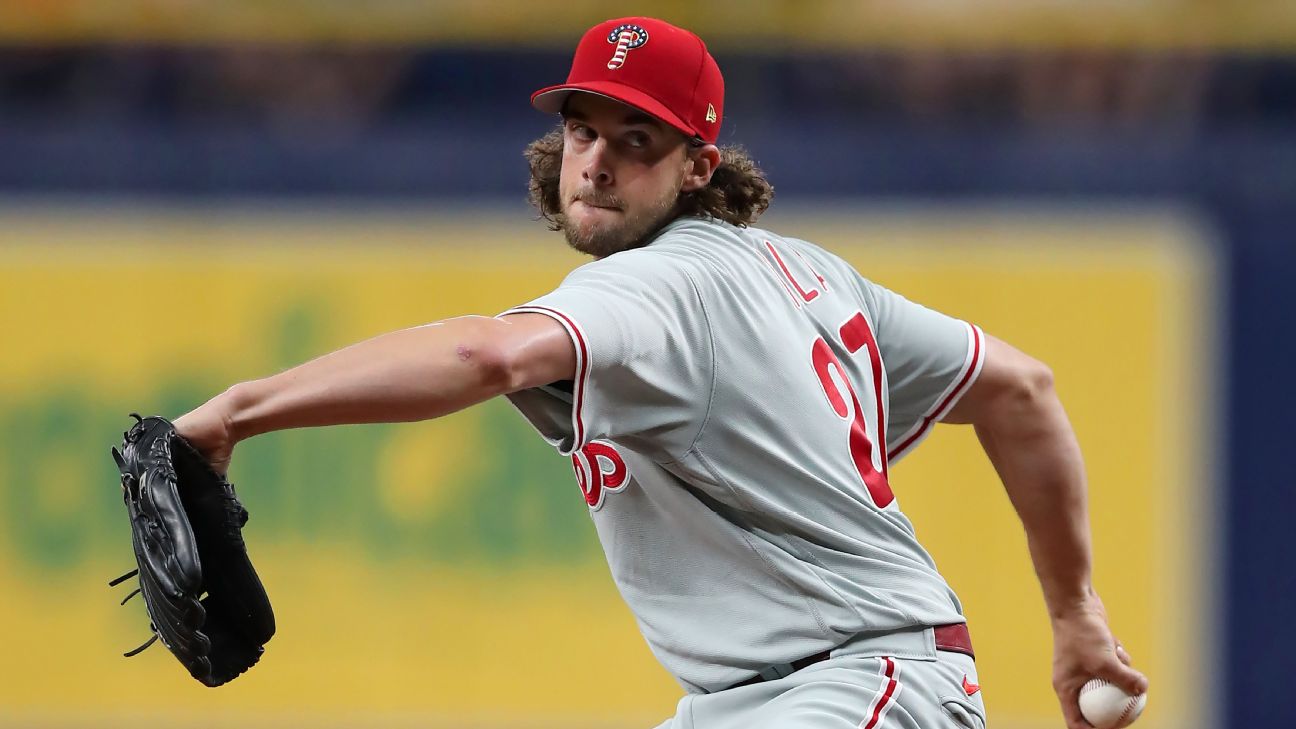
Whether it’s a free agent deal that changes the course of a team’s future or a blockbuster trade that has the league buzzing, our experts are ready to weigh in.
A figure of plus-40 runs is outstanding: Since the live-ball era began in 1920, only 13 teams have had three players reach 40 batting runs. In 2023, Freeman was at +56, Betts at +55 and Ohtani at +54 (despite missing most of the final month). From here, we could just add up the totals and rank the teams, but we run into two problems: (1) We’re going to end up with a whole bunch of Babe Ruth/Lou Gehrig Yankees teams from the 1920s and ’30s atop the list; (2) There are teams with two great hitters, but a pedestrian third hitter who still finish high in combined batting runs (including several Barry Bonds-led Giants trios, because Bonds — like Ruth — was so far above the rest of the league).
That’s not exactly what we want here; this isn’t a list of great duos. We want three great hitters. We can account for this by using the harmonic mean of the three numbers, which is a sort of numerical average. You can look up the definition, but here are two examples:
–The 2002 Giants had Bonds (+109), Jeff Kent (+46) and Reggie Sanders (+7). A total of +162 runs, but a harmonic mean of 17.3 since Sanders was just a little above average.
–2023 Braves had Acuna (+63), Olson (+52) and Ozuna (+28). A total of +143 batting runs, but a harmonic mean of 42.4.
I’m looking for trios more like Atlanta’s players — although, another spoiler alert, the Braves didn’t make the top 10 either.
Got it? First, here’s a quick top five of the pre-integration era … all those Ruth/Gehrig teams:
1. 1927 Yankees: Ruth (+102), Gehrig (+102), Earle Combs (+40). Harmonic mean: 67.3
2. 1930 Yankees: Ruth (+96), Gehrig (+95), Combs (+40). 65.3.
3. 1929 Yankees: Ruth (+67), Gehrig (+56), Tony Lazzeri (+51). 57.3
4. 1931 Yankees: Ruth (+97), Gehrig (+83), Ben Chapman (+31). 54.9.
5. 1930 Giants: Bill Terry (+65), Mel Ott (+52), Fred Lindstrom (+44). 52.3.
Two more Ruth/Gehrig teams make the top 10 from this era. We get it: Those two were pretty good.
(We don’t want to ignore the Negro Leagues, although it’s difficult to make the statistical comparisons. For a few years, the St. Louis Stars ran out a big three of Mule Suttles, Willie Wells and Cool Papa Bell, all Hall of Famers, and Suttles was the second greatest slugger in Negro Leagues history behind Josh Gibson.
The 1933-36 Pittsburgh Crawfords had four Hall of Famers in Gibson, Bell, Oscar Charleston and Judy Johnson. Charleston is considered the best all-around player in Negro Leagues history — think Willie Mays — but was past his prime by then, as was Johnson. Gibson then teamed up with Buck Leonard – referred to as the Black Lou Gehrig – with the Homestead Grays, and while the Ruth/Gehrig comparison holds, they lacked a third wheel.)
Now, on to … a much more interesting list.
Modern top 10 MLB batting trios
Besides the 2023 Braves, other honorable mentions include the 1964 Twins (Harmon Killebrew, Bob Allison, Tony Oliva), 1973 Reds (Joe Morgan, Pete Rose, Tony Perez, the best of those Reds teams) and the 2018 Red Sox (Betts, J.D. Martinez and Xander Bogaerts). Now, counting backwards …
10. 2005 Yankees: Alex Rodriguez (+66), Jason Giambi (+43), Gary Sheffield (+35). 44.8.
A-Rod hit .321 with 48 home runs, playing all 162 games, while Giambi and Sheffield both topped 30 home runs with Giambi posting a .440 OBP. A couple other Yankees teams from this era, including 2005 and 2009, were also stacked.
9. 1998 Astros: Jeff Bagwell (+49), Moises Alou (+47), Craig Biggio (+40). 44.987.
The 2000 Astros don’t make it, but the 1998 team does. Bagwell hit .304/.424/.557 with 34 home runs, which wasn’t even his best season. Alou hit .312/.399/.582 with 38 home runs, playing 159 games for a player who was often injured. Biggio hit .325 with a .403 OBP and went 50/50 — 51 doubles and 50 stolen bases.
8. 1993 Blue Jays: John Olerud (+64), Paul Molitor (+43), Roberto Alomar (+36). 45.005.
This was the season Olerud hit .363 with 54 doubles and finished third in MVP voting, Molitor hit .332 with a .402 OBP and finished second and Alomar hit .326 with a .408 OBP (and was sixth in the MVP vote). Each played at least 153 games — durability is a huge key here — and the Jays went on to win the World Series.
Way-too-early 2024 MLB power rankings
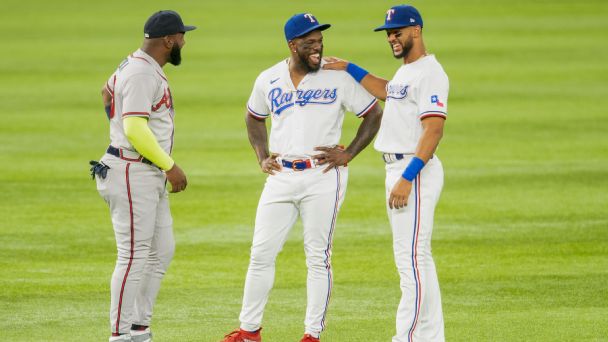
The Rangers won the 2023 World Series — and we’re already looking ahead to rank all 30 teams for next year.
7. 1963 Giants: Willie Mays (+56), Orlando Cepeda (+46), Willie McCovey (+41). 46.9.
We mentioned this group earlier. Unfortunately, they had three infielders with OBPs under .300 and no power, and the Giants finished third in the NL at 88-74. Mays, Cepeda and McCovey played together for six seasons, but this was easily their best collective effort, as McCovey was only a part-time player from 1959 through 1962.
6. 1961 Yankees: Mickey Mantle (+80), Maris (+54), Elston Howard (+32). 48.2.
The M&M boys make our list — although their third-best hitter wasn’t Skowron with his 28 home runs but Howard, who hit .348/.387/.549 with 21 home runs in 482 plate appearances. The Yankees won 109 games and the World Serie but did not lead the AL in runs. More on that other team in a moment.
5. 1996 Indians: Jim Thome (+60), Albert Belle (+57), Manny Ramirez (+36). 48.4.
A couple other Cleveland teams from this era nearly cracked the list as well, and the 1997 team with Thome, Ramirez and David Justice were one of 13 teams with three players with +40 batting runs. The 1999 team, however, scored the most runs with 1,009 and remain the only team in the 162-game era to score 1,000.
4. 1961 Tigers: Norm Cash (+76), Rocky Colavito (+47), Al Kaline (+39). 49.9.
We mentioned Cash and Colavito’s numbers above. Kaline, the Hall of Famer in the group, hit .324/.393/.515. Cash was an excellent hitter with 377 lifetime home runs, but he would admit to using a corked bat in 1961 — he hit .361, the only .300 season of his career.
3. 2004 Cardinals: Albert Pujols (+69), Jim Edmonds (+52), Scott Rolen (+40). 51.1.
Pujols led the way, hitting .331/.415/.657 with 46 home runs, Edmonds hit .301/.418/.643 with 42 home runs and Rolen, in his best season, hit .314/.409/.598. People forget the 2004 Red Sox had to beat this powerhouse lineup to win the World Series.
2. 1996 Mariners: Edgar Martinez (+62), Alex Rodriguez (+58), Ken Griffey Jr. (+40). 51.4.
Not bad when Griffey is your third-best hitter. A-Rod, in his first full season, hit .358 with 36 home runs and 54 doubles. Martinez hit .327/.464/.595 with 26 home runs and 52 doubles. Griffey hit .303/.392/.628 with 49 home runs. And Jay Buhner hit 44 home runs. The Mariners missed the playoffs.
1. 2000 Giants: Barry Bonds (+62), Jeff Kent (+58), Ellis Burks (+45). 54.0.
It wasn’t Bonds’ greatest season — the top three hitters on the 2001 Giant with Bonds, Kent and Rich Aurilia for example, produced more combined batting runs as Bonds set the single-season home run record and came in at +116 all by himself, but the 2000 trio had more balance.
Kent edged out Bonds for the MVP award, hitting .334/.424/.596 with 33 home runs. Bonds hit .306/.440/.688 with 49 home runs. Burks’ monster season puts the Giants over the top, as he hit .344/.419/.606 with 24 home runs — in just 122 games. The Giants won the NL West at 97-65 but lost to the Mets in four games in the NLDS (Burks hit the only home run from the big three).
So where could Betts, Freeman and Ohtani rank? If they do exactly what they did last year, they come in with a harmonic mean of 55.0, which vaults them to the top of the modern list. That could go even higher if Ohtani ends up playing more than the 135 games he played last season.
On the other hand, we could also see some regression from Betts, coming off that +55 season, given he was +29 runs at the plate in 2022. Freeman’s +56 was also a career high and he’s now 34. Even Ohtani was 23 runs better than in 2022 and is coming off the elbow surgery that could slow him down a bit at the start of the season.
Still, there is no doubt this group has a chance to be a historic trio. I have a feeling it will.
